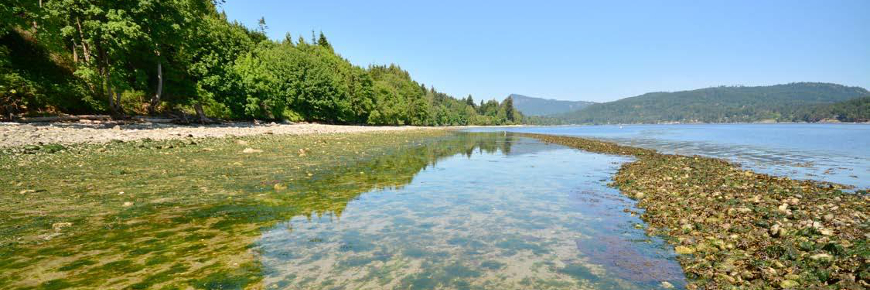
Listening to the sea, looking to the future
Clam garden rejuvenation in Gulf Islands National Park Reserve
What’s the issue?

Since ancient times, the Coast Salish peoples have cared for and relied on beaches to provide a healthy, nutritious supplement to their diet. Using practices passed down through generations, they cultivate intertidal ecosystems by removing sea lettuce and tilling beach sand. These practices encourage growth of many valuable food species in the shallow coastal waters. Building rock walls near the lowest tide-mark helps trap sand and sediment, and create a terrace on the landward side – a perfect environment for clams to grow. Once established, these “clam gardens” support many more clams than unmodified beaches. This cultivated balance has been interrupted in more recent history. But staff in Gulf Islands National Park Reserve, and the WSÁNEĆ and Hul’q’umi’num Nations of the Coast Salish people, are restoring these eco-cultural systems and rejuvenating this ancient practice.
What’s our approach?
- Cooperate with WSÁNEĆ and Hul’q’umi’num Nations to re-establish traditional practices in intertidal ecosystems.
- Enhance ancient clam gardens by rebuilding 275 metres of wall by 2019 and tilling 350 square metres of beach each year.
- Monitor and research the role of clam gardens in restoring intertidal ecosystems.
- Engage visitors and communicate the role of humans (Indigenous peoples, new settlers, Parks Canada) in intertidal ecosystems through social media and outreach activities.
What’s been accomplished?
- Engaged WSÁNEĆ and Hul’q’umi’num Nations to lead planning and restoration activities.
- Built 145 metres of clam garden wall and reached the target area of beach tilling for three consecutive years.
- Began monitoring clams, algae and sediments, and mapped clam gardens using drone technology.
- Conducted underwater mapping and excavations, and collected samples for radiocarbon dating at two clam gardens – anticipated to be much older than the current estimates of 1,000 to 1,700 years old.
- Attracted 110 participants to the 2017 Science and Culture camps; reached 14,000 people at many venues, including Vancouver Aquarium, Shaw Centre for the Salish Sea, and Coast Salish Campfires in 2017.
Related links
- Igniting restoration
- Two pines in decline
- Conserving an alpine enigma
- Rescue the fescue
- Historic homecoming
- Wildlife crossings
- Going with the flow
- Propagating success
- Ecosystem on the edge
- Keeping dunes dynamic
- Wild about wolves
- Restoring kelp in Gwaii Haanas National Marine Conservation...
- Llgaay gwii sdiihlda, or restoring balance
- Date modified :